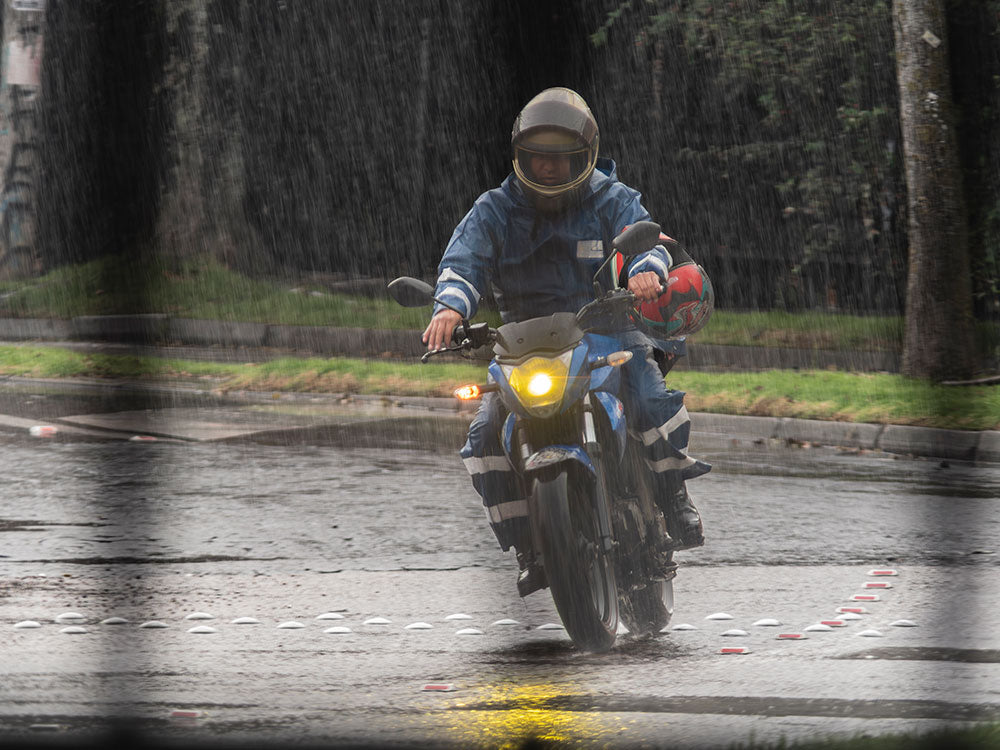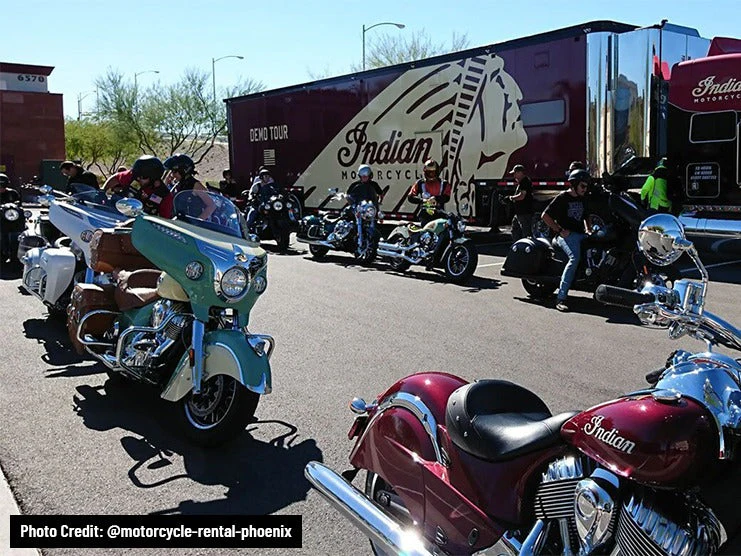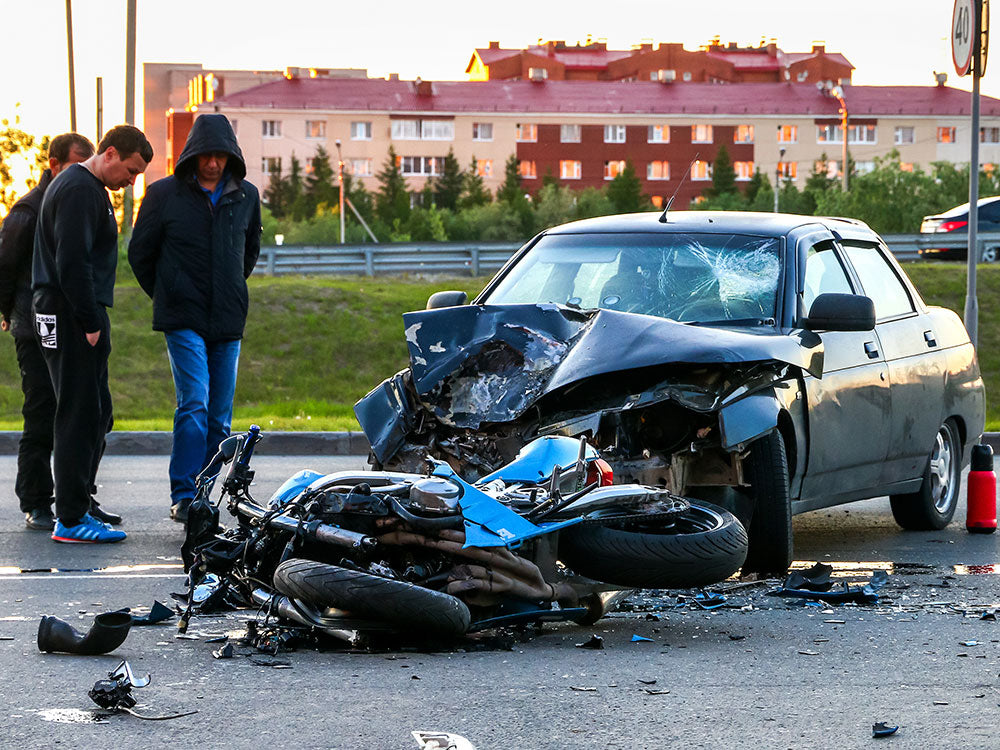Table of Content
A real cause for concern among motorcyclists is unpredictable weather since the chances of getting into an accident are much higher when it is raining. But you can make it safer to ride in the rain by wearing waterproof riding gear, increasing visibility, being aware of slick spots, and knowing other tips and tricks.
1. Invest in Proper Riding Gear
Waterproof clothing is essential for comfort when riding a motorcycle when it is raining. Putting on waterproof and warm riding gear and clothing before heading out will help better shield yourself from bad weather conditions.
Unless riding in severe conditions, such as being submerged in water, waterproof clothes and riding gear will prevent water from seeping in. When exposed to a constant stream of water, water-resistant equipment will cause most water to run off along the surface, but cannot fully prevent water from seeping in.
1.1 Waterproof Clothing
Waterproof clothing may include a waterproof jacket, pants, and a one-piece suit. The key to ensuring maximum protection from rain is by wearing waterproof riding clothing with overlapping seams that don't line up. The zippers should have one or more flaps that fully close, with the flap's edge not aligned with the zipper itself. The jacket's cuffs should also be long enough to cover the bottom of the gloves. It is crucial to stay warm and dry since damp clothing and skin will cause your body temperature to lower and cause your movements to become sluggish.
1.2 Waterproof Gloves and Riding Boots
Waterproof gloves and riding boots must be wrapped tightly around the hands and feet to prevent water from seeping through any openings. They must be tight enough that they can be tucked inside a jacket or raincoat.
Consider bringing a change of dry clothes if your motorcycle is equipped with a tank bag or if you travel with a backpack or saddlebag.
1.3 Plastic Bags
It is recommended you carry extra plastic bags in your motorcycle saddlebags or in sissy bar bags while riding. They can be used to store your valuables, like cell phones, passports, wallets, and etc.
1.4 Full-Face Helmet
A full-face helmet will provide the best protection against rain due to the visor protecting your eyes. Use a balaclava with a protective outer layer to shed water and prevent wind from blowing against your face. The balaclava should be tied to your jacket via straps that loop under your arms. This keeps it from riding up and potentially exposing a seam where water may enter.
In the rain, the helmet’s visor can fog up due to your breathing causing condensation when coming in contact with the cold air. The fogged-up visor can be prevented by opening the helmet’s vents to equalize air temperature inside and outside the helmet.
2. Inspect Your Motorcycle
A few parts need to be checked before you depart on your ride, to make sure your motorcycle is in good condition to travel in the rain.
2.1 Tires
Your tires must be filled at adequate air pressure and have good traction to prevent slipping on slick spots.
If your motorcycle is fitted with newer tires, it will take longer for them to gain better traction than older tires since the oily surface has not had enough time to build up.
2.2 Fenders
Your motorcycle’s front and rear are shielded from the elements by its fenders. Fenders aid in keeping debris from hitting the drive train, extending the drive train's lifespan.
2.3 Brakes
You should have responsive brake s that should allow you to slow down and stop promptly even in rainy weather conditions. Make sure your motorcycle’s ABS is periodically inspected and in good working condition.
2.4 Brake Fluid and Oil
Make sure there are no oil or brake fluid leaks on your motorcycle. In dry conditions, an oil spill does not pose an immediate safety risk. However, mixing water and oil might result in slick, hazardous liquid that could cause your ride to malfunction.
2.5 Chain Lube
It is necessary to check for the proper functioning of different components of your motorcycle before going out for wet weather riding. Give your motorcycle a quick wash and apply lube to the chain. Lube provides protection against dirt, water, and other elements and optimizes the efficiency of the motorcycle.
2.6 Lights
Inspect all motorcycle lighting before riding in the rain. When motorcycling in the rain, being visible to other vehicles should be the rider's top safety concern. Always have a headlight, tail light, and turn signals on while riding.
3. Watch Out for Wet Riding Conditions
Even though roads may look clean, rain frequently causes oils and other slick residues to rise up to the surface. To safely get to your destination, ride slowly and cautiously while keeping an eye out for slick spots in case you need to react quickly.
3.1 Less Traction
Rain causes oils in the roads to come up to the surface, resulting in slick, damp surfaces that reduce traction for your tires. The most hazardous time to ride is during the first hour of a heavy downpour when the oils are along the surface of the road and haven't been washed away yet. Before getting on your motorcycle, wait for the storm to pass or until the rain has properly cleaned the road’s surface of oils and other slick residue left behind. When the rain stops, follow previous tire tracks since they have already cleared some of the water and will offer surfaces with better traction.
3.2 Reduced Visibility
During heavy downpours, the rain, and fog may make it difficult to see what is ahead on the road. While motorcycling in the rain, being reflective or brightly colored is always recommended. They might be the distinguishing characteristic that makes you visible to other vehicles.
3.3 Braking Distance
On a wet road, you should increase the stopping distance and turn corners more slowly and gradually. For maximum contact with the road and reduced water treading, it is important to ride as vertically as possible. It is best you apply light pressure to the front brakes. Install crash bars to protect your motorcycle’s vital components.
3.4 Avoid Riding Over Painted Lines
Try to avoid riding over painted lines since they have less traction when wet. You can cross these lines, but you shouldn't brake or accelerate on them. Additionally, avoid leaning into a turn when riding on a painted line. Simply cross the line at a steady pace when changing lanes.
3.5 Pick a Dry Line
Try to follow the paths where the moisture has been absorbed by other tires. You should be able to see two dry lines clearly on the road. In these dry lanes, your tires should be able to find greater traction.
3.6 Look Out for Diesel or Oil Spills
An oil or fuel spill at a corner can be hazardous since the slippery surface can instantly cause a wipeout. Approach every corner carefully and avoid braking when turning or leaning when it is raining. The safest place to stay is where the tires of the vehicles have cleared the road.
4. Riding Techniques and Routes
The motorcyclist needs to change riding techniques because road conditions change when it rains. Also, riders have to choose the route wisely for safe riding.
4.1 Avoid Obstacles
When riding in wet weather, be careful around storm drains, maintenance hole covers, damp leaves, and other slippery areas. If you can't avoid them, avoid braking while riding on top of them. Avoid puddles whenever you can since you might not be able to gauge the depth.
4.2 Brake Early
When riding in the rain, make it a habit to brake early when you see vehicles ahead of you stopped or red light. Since a wet surface can result in your vehicle skidding or taking a split second longer for the tires to catch onto the road, you may need more time to stop to avoid rear-ending another vehicle.
4.3 Plan Your Route
You should plan a backup route in case downpours cause roads to close, as well as a rest area where you can stay parked until the weather improves. Mark your favorite restaurants, break areas, or other destinations on your GPS or paper map so you can quickly navigate to where you need to go if required.
4.4 Stay in the Right Lane
Riding in the right traffic lane may prompt other drivers to give you more space. Maintaining a position in the center or right third of the outer lane will make you more visible to oncoming traffic. This also gives you more time to avoid slamming into a vehicle.
5. Practice Safe Riding Techniques
You can enjoy a safe ride in wet weather by learning some techniques.
When the road becomes slick, you can lower tire pressure to improve traction.
Always use the brakes before turning into a corner to prevent your tires from locking up. Maintain a slow and steady speed and avoid braking abruptly.
Avoid tailgating or following another vehicle too closely. Always maintain a large gap between yourself and the vehicle in front of you.
6. Don’t Ride Aggressively & at High Speed
Never go faster if you feel uncomfortable doing so while riding your motorcycle. Allow the slowest motorcyclist to lead the group if you're riding with others. Nothing is worse than attempting to keep up by going outside your comfort zone.
Constant balancing is required to maintain cruising speed if there is low visibility. Ride slowly so you have enough time to spot and react to incoming dangers. If it's really foggy, this becomes impossible, so your best bet is to pull over until the weather clears up.
7. Ride Smoothly
For safe riding in wet weather, it is recommended you try to ride less aggressively. When riding in the rain, everything (throttle adjustment, cornering, braking) should be smooth. Smooth riding can prevent you from suddenly losing traction which may result in you crashing.
Riding smoothly ensures better tire grip and reduces the risk of slipping. Also, try to avoid leaning and keep your motorcycle upright as much as possible to reduce the risk of sliding.
You will also need to ride smoothly when changing directions. Avoid suddenly braking and turning in wet weather to prevent your tires from losing their grip.
8. Last Words
Riding a motorcycle in the rain can be challenging but can also be a lot of fun. Most people avoid riding in rainy weather since it is possible for their motorcycles to slide, have low visibility, and lose traction which could result in serious accidents. But knowing how to safely ride in wet weather can help reduce the risk of crashing and make riding more enjoyable.













Leave a comment
All comments are moderated before being published.
This site is protected by hCaptcha and the hCaptcha Privacy Policy and Terms of Service apply.